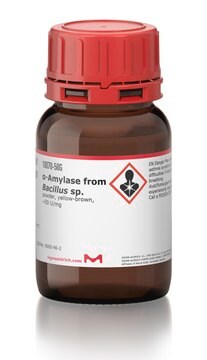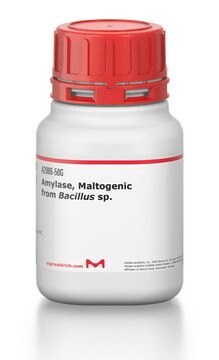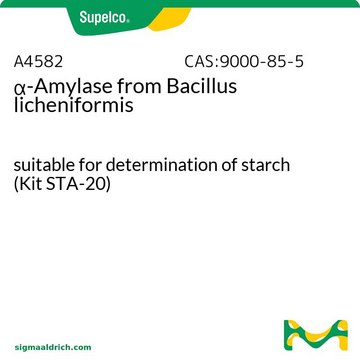A7130
β-Amylase from barley
Type II-B, 20-80 units/mg protein (biuret)
Synonym(s):
1,4-α-D-Glucan maltohydrolase
Sign Into View Organizational & Contract Pricing
All Photos(5)
About This Item
Recommended Products
type
Type II-B
Quality Level
form
powder
specific activity
20-80 units/mg protein (biuret)
greener alternative product characteristics
Waste Prevention
Design for Energy Efficiency
Learn more about the Principles of Green Chemistry.
sustainability
Greener Alternative Product
greener alternative category
, Enabling
shipped in
wet ice
storage temp.
2-8°C
Looking for similar products? Visit Product Comparison Guide
General description
We are committed to bringing you Greener Alternative Products, which adhere to one or more of The 12 Principles of Greener Chemistry. This product has been enhanced for energy efficiency and waste prevention when used in starch ethanol research. For more information see the article in biofiles.
Application
β -Amylase is used to hydrolyze α bonds of α-linked polysaccharides, such as starch and glycogen. β -Amylase, has been used in various plant studies, such as carbon starvation studies in Populus tremuloides . β -Amylase, from barley, has been used to study how pressure and temperature affect catalytic activity .
Biochem/physiol Actions
β-Amylase hydrolyzes the α-(1,4) glucan linkages in polysaccharides of three or more α-(1,4) linked D-glucose units. Natural substrates such as starch and glycogen are broken down into glucose and maltose. Pure, crystalline β-amylase preparation consists of four isoenzymes with different isoelectric points. The enzyme polymerizes very rapidly through the sulfhydryl groups in the absence of reducing agents. p-Chloromercuribenzoate inhibits the polymerization and the enzymatic activity. The reducing agents mercaptoethanol or dithiothreitol can completely restore the activity.
Quality
Crude
Unit Definition
One unit will liberate 1.0 mg of maltose from starch in 3 min at pH 4.8 at 20 °C.
Other Notes
View more information on enzymes for complex carbohydrate analysis at www.sigma-aldrich.com/enzymeexplorer
Signal Word
Danger
Hazard Statements
Precautionary Statements
Hazard Classifications
Resp. Sens. 1
Storage Class Code
11 - Combustible Solids
WGK
WGK 3
Flash Point(F)
Not applicable
Flash Point(C)
Not applicable
Personal Protective Equipment
dust mask type N95 (US), Eyeshields, Gloves
Choose from one of the most recent versions:
Already Own This Product?
Find documentation for the products that you have recently purchased in the Document Library.
Customers Also Viewed
Volker Heinz et al.
Biotechnology progress, 21(6), 1632-1638 (2005-12-03)
The depolymerization of starch by beta-amylase during exposure to hydrostatic pressure up to 700 MPa and within a temperature range from 20 to 70 degrees C has been investigated. Inactivation of the enzyme as well as alterations in conversion speed
Purification and characterisation of crystalline -amylase from barley.
K Visuri et al.
European journal of biochemistry, 28(4), 555-565 (1972-08-04)
Xin Li et al.
Journal of industrial microbiology & biotechnology, 38(11), 1837-1843 (2011-04-21)
A moderately halophilic strain LY9 with high amylolytic activity was isolated from soil sample obtained from Yuncheng, China. Biochemical and physiological characterization along with 16S rRNA sequence analysis placed the isolate in the genus Halobacillus. Amylase production started from the
Déborah LeCorre et al.
Biomacromolecules, 13(1), 132-137 (2011-12-03)
Starch nanocrystals (SNCs) are crystalline platelets resulting from the acid hydrolysis of starch. A limiting factor for their more widespread use is their preparation duration. Therefore, this study investigates the possibility of developing an enzymatic pretreatment of starch to reduce
Ambarish Nag et al.
BMC systems biology, 5, 94-94 (2011-06-21)
Higher plants and algae are able to fix atmospheric carbon dioxide through photosynthesis and store this fixed carbon in large quantities as starch, which can be hydrolyzed into sugars serving as feedstock for fermentation to biofuels and precursors. Rational engineering
Protocols
Enzymatic Assay of β-AMYLASE (EC 3.2.1.2)
Our team of scientists has experience in all areas of research including Life Science, Material Science, Chemical Synthesis, Chromatography, Analytical and many others.
Contact Technical Service











